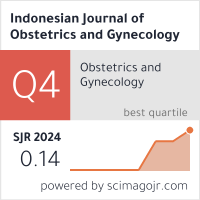Correlation of Total Antioxidant Capacity Measured by Ferric Reducing Ability of Plasma (FRAP) Assay with the Severity of Preeclampsia
Abstract
Objective: To analyze correlation between total antioxidant capacity measured by Ferric Reducing Ability of Plasma (FRAP) assay with severity of preeclampsia. Method: The cross sectional method was used in this study to compare TAC of four different groups of study, consists of normal pregnancy, mild preeclampsia, severe preeclampsia and eclampsia. The study consisted of 15 women in each group. All of the subjects met the inclusion criteria and were admitted to Dr. Hasan Sadikin Hospital and it’s district hospital. The study was conducted from August until September 2011. 3 ml blood samples were taken and were measured by FRAP assay in the laboratory PRODIA Jakarta. Result: There was no significant difference (p<0.05) on subject’s characteristics based on number of parity and gestational age among the groups of study. The comparison of TAC measured by FRAP assay based on ANOVA was significant difference (p<0.01). The highest mean FRAP assay result appeared in eclampsia which was 1441.1±315.8, while in severe preeclampsia 1118.8±118.3, mild preeclampsia 902.4±102.5 and in normal pregnancy 769.3± 117.1. There was significant (p<0.05) positive correlation (ratio 0.880) between TAC measured by FRAP assay with severity of preeclampsia. Based on prevalence ratio with CI 95% subjects with FRAP level ≥ 769.3 had about 2.17 times higher risk to develop mild preeclampsia and subjects with FRAP level ≥ 769.3 had about 2.5 times higher risk to develop severe preeclampsia or eclampsia. Conclusion: There was a very strong positive correlation between TAC measured by FRAP assay with the severity of preeclampsia. [Indones J Obstet Gynecol 2011; 35-4: 155-60] Keywords: FRAP assay, total antioxidant capacity, preeclampsia-eclampsiaDownloads
Download data is not yet available.













